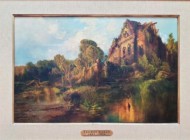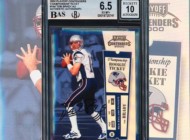NEW YORK CITY — In the years during and following World War II, the now famous Monuments Men were responsible for the restitution of approximately five million cultural objects, four million of which were stolen, as part of the mission of the U.S. Monuments, Fine Arts, and Archives (MFAA) program. One of these men was Sargent Kenneth Lindsay, an art historian and professor from Wisconsin who, in 1944, found himself marching through France. When the fighting was over he quickly transferred to MFAA, working under the leadership of Walter Farmer at the Wiesbaden Central Collecting Point. There the Monuments Men sorted and catalogued stolen works of art stored in Nazi repositories, ultimately returning them to their rightful owners.
A token of his appreciation of Lindsay’s work, Farmer gave his a watercolor by George Grosz (1893-1959), titled “Im Café” (a seminude woman with champagne glass on verso), which is being offered in Heritage Auctions Modern & Contemporary Art Auction on November 11 (today) at the Fletcher-Sinclair Mansion (The Ukrainian Institute), 2 East 79th Street.
Grosz was among the most important early Twentieth Century artists in Berlin; the painting depicts a couple in one of his favorite places for observation: a Berlin coffeehouse.
When the U.S. Army ordered that more than 200 German-owned paintings be transferred to the National Gallery in Washington, D.C., Farmer and Lindsay joined forces with 30 other Monuments Men in opposition of the demand. Their resistance coalesced in the Wiesbaden Manifesto, a petition requesting that the Army abandon its efforts, which they deemed morally untenable. More than 50 years later, Lindsay would go on to publish the article “Official Art Seizure under the Military Cloak” in the journal Art, Antiquity, and Law.
For more information, www.ha.com.





